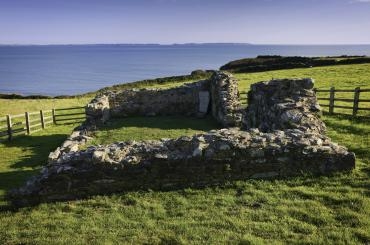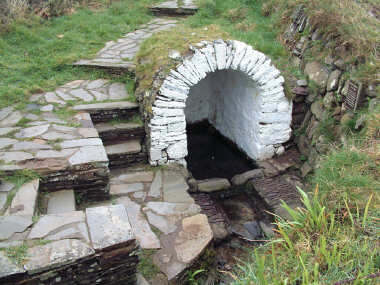Saint Non mother of David patron saint of Wales

Saint David (Welsh: Dewi Sant c. 500 – c. 589) is the patron saint of Wales. Celebrations are taking place today on March 1st, St David's Day, recognised as a National Day throughout Wales. The date is tradionally seen as that on which Saint David died in 589. He was a Welsh bishop of Mynyw, now St Davids (Welsh: Tyddewi) during the 6th century. He is traditionally believed to be the son of Saint Non and the grandson of Ceredig ap Cunedda, King of Ceredigion.
Most of what is known about Saint Non comes from Rhygyfarch (1057–1099) who was the author of the standard Life of Saint David, written around 1095. Rhigyfarch recounts the tradition that Non was violated by Sanctus, Prince of Ceredigion, after resisting his advances. Rhigyfarch states that she was a nun at Ty Gwy near Porth Mawr in Pembrokeshire (Welsh: Sir Benfro). David was the product of this assault. Non gave birth to Saint David in the place now named Capel Non. The ruins of the Chapel of St Non can still be seen and next to it is a holy well, covered by a stone arch, dedicated to Saint Non. A number of such holy wells can be found throughout the Celtic nations and are traditionally believed to possess curative powers. Nearby there is a modern retreat house, and a chapel dedicated to Our Lady and Saint Non built in 1934.
The ruins of the Chapel of Saint Non have been difficult to date. There is reference to a chapel on the site in a document dated 1335. An excavation on the site also revealed slab lined graves of the early Christian period. There is a carved standing stone, found close to the chapel, that has been dated to between the 7th and 9th century. It is inscribed with a cross within a circle and is known as the Cross of Saint Non. The cliff side site of the ruined chapel is said to be where, during a violent storm, David was born. She was said to have endured great pain when giving birth and as she grasped a rock with her fingers they left marks. A lightening strike then struck the rock, splitting it in two. Legend has it that this stone is now concealed in the foundations of the chapel altar. Another interesting factor in the location of the chapel field is that there are a number of ancient standing stones. Pointing to the possibility that the chapel was built within an original pagan stone circle.
It is said that Saint Non, also known as Nonna or Nonnita, led the rest of her life in great piety. It is believed that Saint Non died at Dirinon, Brittany, (Breton: Dirinonn, Breizh) and is buried there. A shrine to her (Saint Nonne) can still be seen in Dirinon's parish church. There are other churches in Wales that are named after Saint Non. She is also the patron of Pelynt (Cornish: Pluwnennys, Pluwnonna) in Cornwall (Kernow) where there is St Nonna's Holy Well. However, it is the site of the 6th-century birthplace of the patron saint of Wales, Saint David, that is perhaps the most evocative. Not only is it a significant holy and cultural site, it is located along one of the most stunning stretches of the Pembrokeshire Coast National Park (Welsh: Parc Cenedlaethol Arfordir Penfro). Overlooking the breathtaking views of Saint Non’s Bay which will forever bear her name.
Images: Chapel of Saint Non courtesy of Cadw. Saint Non's Well






